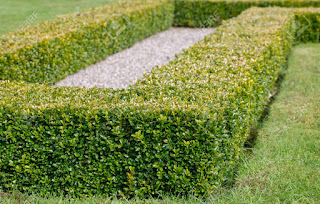 |
| English lavender |
What great holiday weather North Otago has been experiencing during the end of January, a summer to remember for holiday makers. As a Gardener I have been loving the warmth and keeping the fitness up by dragging hoses around to keep plants and grass alive. This week I have been keeping on top of the weeds with the hoe and spray. Gravel walkways and drives are germinating areas for weed seeds. Round up is used on the established weeds and organic weed spray works well on weeds at the early stage of growth.
Hedges can have a light trim to tidy them up, overcast days are the best time to do this so that the growth beneath is not too stressed by the hot sun. My Bob has spent many hours lately trimming box hedges until they look sharp and neat.
All plants can do with a good feeding now because they have flowered well since the beginning of Summer, foliage feeding is great but if feeding with dry fertiliser around roots it should be watered in well, if left to sit on top it will burn exposed roots. A layer of compost around roots will help retain moisture and add nitrogen to retain vigor in plants, trees and shrubs through to the end of the growing season.
.
Keep dead heading roses and remove all old leaves with black spot and rust and destroy, don't leave them lying on the ground around roses. Deep soak around roots often and if needed spray fortnightly with a fungus and pesticide mix as well as liquid fertiliser, (all together is fine) There are some organic options available, continuous hot dry weather really stresses roses.
All Hebe's will be running to seed now and really benefit from a good cut back at this stage to keep them from becoming leggy.
Dead head all flowering plants and shrubs to encourage continuous flowering and prevent seed being set.
Lavender: English lavenders ( The tall straight single flower head type) are are in full flower now, bunching for drying can be done once stems have firmed and lavender heads have been pollinated towards seed stage, picked earlier stems will be too soft. If you have very woody lavenders, cut them back by two thirds after picking, they will regrow fresh and bushy and make hard wood again before winter. If too old and woody they will probably not put out new growth so take cuttings from what you cut back and grow a few new plants by pushing into wet river sand.
Lawns: Do not take long to bake hard during a hot dry summer, don't cut too low. I have found if they are encouraged to make top growth grass will develop deeper stronger roots. A sprinkle of water now and then on dry grass will produce weak growth, a good soak and feeding during natural rain is what is needed.
Vegetables: gardens will be stressed during this dry spell needing moisture kept up if sowing seeds and seedlings, shade could be erected along rows to protect produce from all day heat, plants will continue good growth as long as they get full overhead light. Tomatoes are enjoying the hot spell and should be ripening well, they are heavy feeders needing added nutrients through the season to grow fast and ripen within the warmest months.
Fruit:
My apple, late ripening peach, apricot, quince and walnut trees are laden and I see local cherries still on sale, what a difference continuous sunny days make to fruit ripening compared to those overcast summer days in past years.
Nip back the growth on grapes to let sun in and stunt leaf growth, the fruit needs all the vine can give now to ripen.
Cheers, Linda.
 |
| Hedge trimming time |







